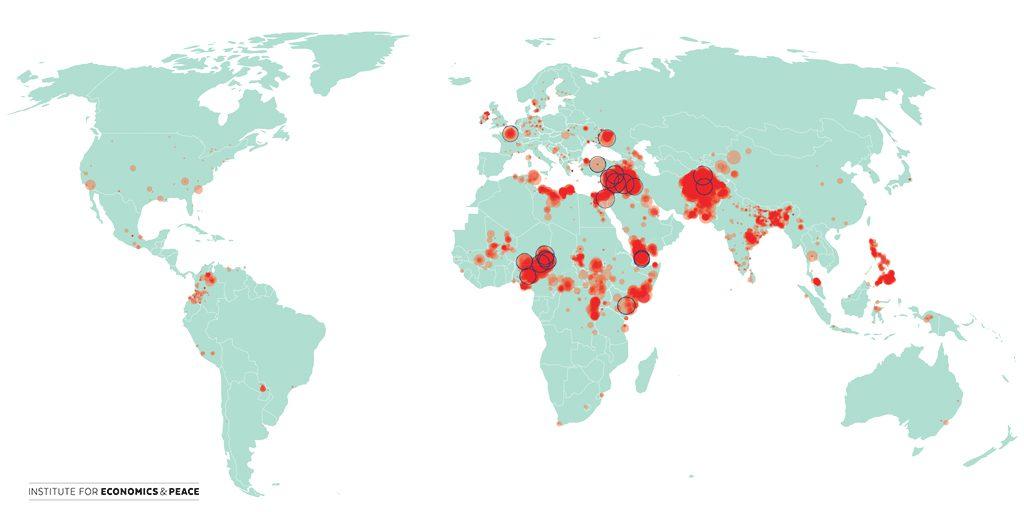Global Terrorism Index 2016 brings context to our challenging time
Posted By Sofia Patel on November 17, 2016 @ 11:05

The Islamic State has been the focus of international counterterrorism operations for the past two years. Despite military operations successfully reducing the IS caliphate over the past 12 months [1], the 2016 Global Terrorism Index (GTI) paradoxically shows that the group has expanded its global reach. According to the Index, which had its Australian release last night at ASPI, IS’s transnational appeal has resulted in a 650% increase in terrorist-related deaths in OECD countries—577 in 2015, up from 77 the year before.
The immediate terrorist threat can be broken down into three groups: foreign nationals fighting abroad for IS, returning foreign fighters, and home-grown inspired or directed terrorists. Governments have urgently ramped up counterterrorism efforts to mitigate the security threats posed by IS, their international appeal and their growing reach.
The Index calculates the global impact of terrorism in 2015 to be US$89.6 billion. Although a substantial figure indeed, put into context, this figure represents just 1% of the total global economic impact of violence, which reached $13.6 trillion in 2015. Terrorism is just one form of global violence, with many other forms coming in as vastly more costly, both personally and economically. For example, the data shows that major armed conflicts resulted in more deaths in 2015 and the global homicide rate in 2015 was 15 times more than the total deaths from terrorism.
The main threat to the OECD is that posed by so-called lone actor attacks. Although those attacks aren’t new, their frequency is increasing. That’s because the bar has been lowered for terrorist attacks; operational success can be achieved with low-level planning sophistication and modus operandi. The 2015 Index reports that of the 64 IS-related attacks in OECD countries, 19 were directed by IS; half of all IS-related plots were perpetrated by lone actors with no direct contact with the group. IS-attributed attacks in OECD countries continue to increase year-on-year: 13 in 2014, 33 in 2015, and 22 in the first half of 2016.
Inspired attacks are different to directed attacks: they don’t require any form of contact with the organisation they purport to represent. Although inspired attacks have been more frequent, directed attacks have been more lethal. According to the data, four of the 10 deadliest IS-related attacks in the OECD since 2015 were carried out by IS: the Paris attacks, Ankara bombings, Ataturk Airport attack, Brussels attacks. The total number of fatalities reached 327, with over 1,300 people injured.
The lethal nature of directed attacks in the OECD mirrors the nature of terrorist attacks in developing countries: a direct connection or link to a terrorist organisation proves more catastrophic than attacks conducted by individuals.
In 2015, over 80% of all terrorist-related deaths occurred in just eight countries (Iraq, Afghanistan, Nigeria, Syria, Yemen, Pakistan, Egypt and Somalia) at the hands of IS, the Taliban, Boko Haram and al-Qa’ida either as a result of battlefield clashes or a terrorist attack. Those figures demonstrate two interesting trends that influence the levels of terrorist activity. First, as seen in OECD nations, a connection to the terrorist organisation—whether geographically or operationally—results in more frequent and lethal attacks. Second, almost all incidents occurred in politically unstable countries and conflict zones.
The report highlights that political violence committed by a state is another driver of terrorist activity. Between 1989 and 2014, 93% of all terrorist attacks occurred in countries with high levels of state sponsored terror and over 90% of all terrorist deaths occurred in countries already engaged in some form of conflict. Only 0.5% of terrorist attacks occurred in countries that didn’t suffer from conflict or political terror.
Over 2015, Boko Haram and IS’ capabilities have been weakened in their designated territories as a result of military operations. However, sustained conflict and poor levels of political stability in developing nations allows for terrorist planned attacks to maintain successful operations in a handful of countries. For instance, 2015 was recorded as the deadliest year for Taliban-related attacks in Afghanistan, and deaths as a result of terrorism increased by 29% (4,502 deaths) and as a result of battlefield clashes, increased 24% (15,000+ deaths). That underlines the importance of presenting terrorist attacks against an international backdrop so proportionate analysis can be drawn. Cherry-picking information can result in a skewed observation of the facts. Due to the international attention on IS, the actions of groups such as the Taliban continue to operate under the radar. Without putting the entire terrorist operational picture into context, understanding the true extent of international terrorist threat won’t be possible.
Even though the numbers of terrorist-related deaths may have decreased by 10% over the last year—the first decline since 2010—the pattern of frequent, transnational, low-capability, inspired attacks poses new threats to international security. The nature of international terrorism is complex, multi-faceted and fluid. Counterterrorism analysts should be wary before drawing predictions based on that decline for the coming months and indeed, years.
Article printed from The Strategist: https://aspistrategist.ru
URL to article: /global-terrorism-index-2016-brings-context-challenging-time/
URLs in this post:
[1] successfully reducing the IS caliphate over the past 12 months: http://www.independent.co.uk/news/world/middle-east/as-isis-s-caliphate-crumbles-jihadist-tactics-are-evolving-a7369346.html
Click here to print.